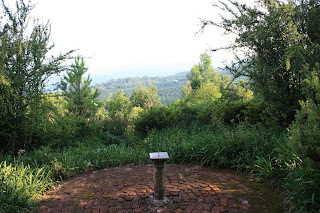The 4th of January. Canucks are leading the NHL, and we are driving into the Kalahari Desert and the Khutse National Reserve.
Being that this is summer in the Kalahari, it is surprisingly green and lush. December is the rainy season, and as of late there has been a fair amount of rain. By "fair amount", I mean the road to our Guest Lodge seemed like a washout at times.
The Lodge is, as described by Tig, bizarre. In the middle of the desert, 100km from nowhere, a bunch of sparkling clean thatched rondawels, a dining room for 100 in the palatial main lodge, an algae-green swimming pool, and no one here. An empty parking lot. No other guests, two young female staff who were able to register us, but that was the end of their English. There are suggestions of game-viewing drives, interpretive walks with San guides, but no indication of how to sign up for such. A real head-scratcher... but we came 100+km on deterioration dirt roads through a desert in the rain to this, so we will try to make the best of it. David Livingston didn't have it so good.
Now we find the actual Park is inaccessible to us. The sand is feet deep, and the ruts are such that it was rubbing the crankcase at times. Diahatsu is tough, but we weren't going to get stranded in the desert. No problem, the only other vehicle in the lot is a Land Rover, that must be for the tours.
When the manager showed up in the afternoon, he explained that they couldn't take us into the park, as their license to go into the park is expired. And they are out of pool chemicals. We are 100km from nowhere, the only guests in a 4-star resort, with no amenities. They have the original Trivial Pursuit game cards, but only half the game board. Oh, it was recommended we not walk around at night, as there are puff adders, and possibly a leopard, about.
I guess we will retire early, when they shut off the generator. And our ceiling fan stops.
Still, the Kalahari, off in the flat distance, is beautiful. The sun set a long way away on a green horizon. As the stars (and snakes) came out, we tucked into their dwindling beer supply, and asked each other trivia questions from 1986.











































